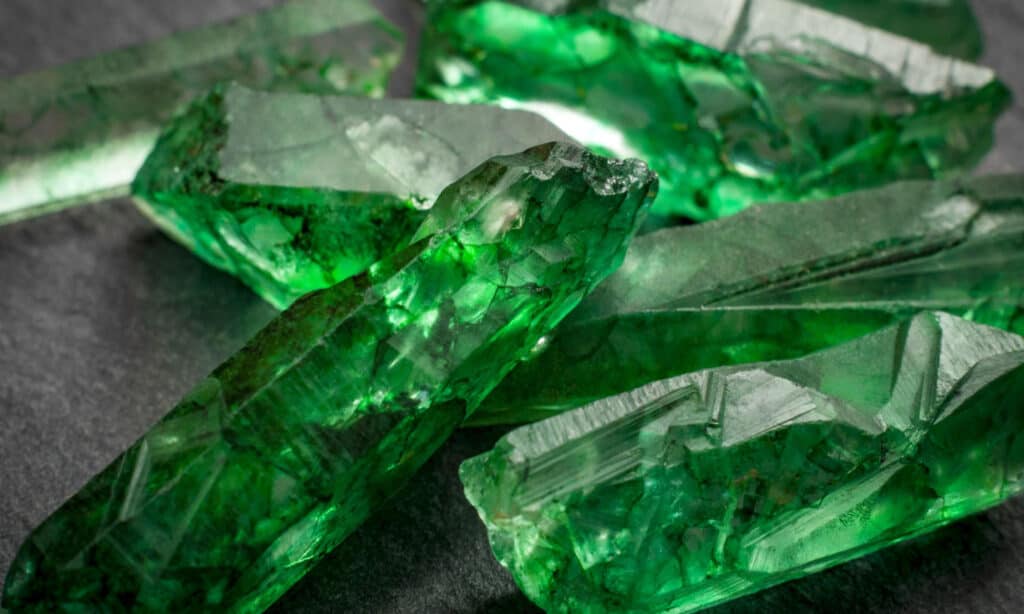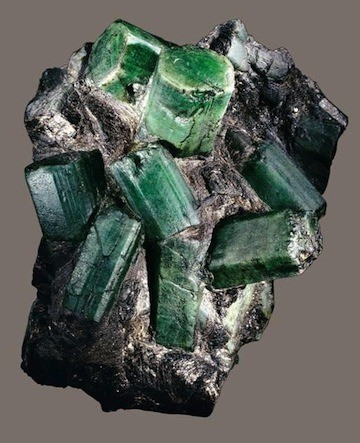Emeralds are one of the rarest gemstones in the world. They are actually more rare and more expensive than even diamonds. Emeralds date back around 3 million years, but they were first mined in Egypt in 1,500BC. However, although they are found widely around the world, nowadays most emeralds are mined in Brazil, Colombia, and Zambia. When emeralds are first unearthed during the mining process, they look nothing like the small gems we probably imagine. Instead, they are often found as crystals that can vary in size. Some are even discovered in large blocks containing several emerald crystals embedded together. So just how big was the largest emerald ever discovered? Join us as we find out!
What are Emeralds?

Emeralds are usually dark green in color.
©Victor Moussa/Shutterstock.com
Emeralds are gemstones that form from the mineral beryl. Or to be specific, they form from a mixture of aluminum, beryllium, oxygen, and silicone. All of these elements are found deep in the Earth’s crust. These elements are all in hydrothermal veins which are filled with hot water. As the water cools under certain conditions emerald crystals begin to form. Like all gems, emeralds have a certain shape that they typically develop in – this is known as a habit. Most emeralds form in a six-sided prism, although they can be in other shapes and forms too.
Emeralds are usually a distinctive dark green color, but other acceptable hues include blue-green and yellow-green. Emeralds get their green coloration from the inclusion of small amounts of chromium or vanadium in them. However, one of the reasons that emeralds are so rare is that the specific formulation that is necessary to create the unique coloration doesn’t happen very often. This means that there are very few of them around.
The Largest Emerald ever Discovered
The largest emerald ever discovered as a single crystal is an emerald named Chipembele which weighs a massive 3.3 pounds. This incredible emerald was discovered in a mine in Zambia. Chipembele was discovered in July 2021 at Kagem mine which is the largest emerald mine in the world. The stunning gem is 7,525 carats and is worth an estimated $2.45 million! It is a perfect green hue and one of the most sought after emeralds in the world.
Chipembele is also known as the Rhino Emerald and there is a story behind its name. When it was discovered, the geologists who found it shouted “look at this rhino horn” due to its impressive size. The name stuck and the emerald became known as Chipembele which means “rhino” in the local Bemba language. Additionally, Kagem, hailed for its conservation efforts has donated a portion of the sale proceeds to a local black rhino conservation group.
The Bahia Emerald

The Bahia emerald is the largest emerald discovered as a block.
©bhcourier.com / Creative Commons – License
Although Chipembele is the largest emerald found as a single crystal, the largest emerald discovered as a block is the Bahia emerald. The Bahia emerald is a large block of emerald crystals and was discovered in Bahia, Brazil in 2001. Containing approximately 1,700,000 carats and worth an estimated $400 million dollars (at least), the Bahia emerald is one of the most expensive and revered gems in the world.
However, despite its incredible appearance and huge price tag, some claim the Bahia emerald is cursed, and the rumors are not without cause. For starters, it was almost lost during the devastating Hurricane Katrina in 2005 while it was stored in a New Orleans warehouse. But that is nothing to what came later.
The Bahia emerald has been stolen, found, and is the subject of numerous ownership disputes. It has also been in the custody of the Los Angeles Sheriff’s Department, and has been the subject of protective restraining order issued by the Department of Justice just to stop anyone else from selling or moving it!
Even now the legal battles over the Bahia emerald continue. It is currently held in a secret location in LA where it is likely to remain until the case is finally settled.
Grading of Emeralds
Emeralds are typically used in jewelry making. They are therefore graded to determine their value based on their quality. Grading is done using the four C’s – color, clarity, cut, and carat weight. With most other gemstones the color is the most important factor in determining the grade. However, with emeralds, clarity comes a close second behind the color. As we’ve already mentioned, most emeralds are green, although hues of blue-green and yellow-green are also acceptable. Despite this, when it comes to color, only medium to dark tones are considered to be true emeralds. Instead, the lighter tones are called green beryl. When grading them the best emeralds are around 75% if 0 is colorless and 100 is black.
Almost all emeralds have fissures or other kinds of small imperfections on their surface. The fewer imperfections that they have, the greater the clarity of the gemstone. Due to these imperfections, most emeralds are oiled using cedar oil (or other similar liquid). This is to fill in the cracks and improve the clarity. Additionally, the presence of these fissures on the surface of the emerald influences the shape of the cut. Rather than cutting all emeralds in a strictly uniform shape such as a rectangle or a typical oval shape, many emeralds are cut in a carbochon form. This is when they are cut into a rounded or oval shape with a convex upper and a flat reverse.
When it comes to the carat, weight is what determines the rarity of the emerald and its eventual price tag. Although carat weight is essentially just the weight of the emerald, the price tag is always much, much higher for larger emeralds. This is due to the fact that really large ones are so rare.
The photo featured at the top of this post is © Victor Moussa/Shutterstock.com
Thank you for reading! Have some feedback for us? Contact the AZ Animals editorial team.






